Computer Networking > EXAM > Chapter 3 Network Management > Business Data Networks and Security, 11e (Panko)>Latest 2019>Already (All)
Chapter 3 Network Management > Business Data Networks and Security, 11e (Panko)>Latest 2019>Already Graded A+
Document Content and Description Below
1) In QoS, the S stands for ________. A) software B) security C) service D) satisfaction Difficulty: Basic Question: 1a Objective: Discuss quality of service and service level agreements. A... ACSB: Applying Information Technology 2) QoS is quantified through ________. A) criteria B) consensus C) metrics D) none of the above Difficulty: Basic Question: 1b Objective: Discuss quality of service and service level agreements. AACSB: Applying Information Technology 3) Transmission speed is normally measured in ________. A) bits per second B) bytes per second C) octets per second D) none of the above Difficulty: Basic Question: 2a Objective: Discuss quality of service and service level agreements. AACSB: Applying Information Technology 4) Throughput is ________. A) the speed a network actually provides to users B) a network's rated speed C) both A and B D) neither A nor B Difficulty: Basic Question: 3a Objective: Discuss quality of service and service level agreements. AACSB: Applying Information Technology, Application of Knowledge 5) Users of an access point share the transmission capacity of the access point. The throughput a user gets is called the ________. A) rated speed B) aggregate throughput C) individual throughput D) all of the above Difficulty: Deeper Question: 3b Objective: Discuss quality of service and service level agreements. AACSB: Applying Information Technology, Application of Knowledge 6) In a coffee shop hot spot, the rated speed is 10 Mbps. Throughput is about half of the rated speed. There are ten people using the hot spot. If you and three others are transmitting or receiving at the same time, what speed should you expect to get? A) 0.5 Mbps B) 1 Mbps C) 1.25 Mbps D) none of the above Difficulty: Deeper Question: 3c Objective: Discuss quality of service and service level agreements. AACSB: Applying Information Technology, Analytical Thinking, Application of Knowledge 7) In a coffee shop, there are ten people sharing an access point with a rated speed of 2Gbps. The throughput is half the rated speed. If each person downloading is getting an average of 200Mbps, how many people are using the Internet at that moment? A) 10 B) 5 C) 2 D) none of the above Difficulty: Deeper Question: 3d Objective: Discuss quality of service and service level agreements. AACSB: Applying Information Technology, Analytical Thinking, Application of Knowledge 8) Trunk lines in the Internet core are ________. A) dedicated B) multiplexed C) both A and B D) neither A nor B Difficulty: Deeper Question: 4a Objective: Discuss quality of service and service level agreements. AACSB: Applying Information Technology, Analytical Thinking, Application of Knowledge 9) The business benefit of multiplexing is ________. A) lower cost B) higher speed C) avoiding the need to send many transmission links through narrow conduits D) security Difficulty: Basic Question: 4c Objective: Discuss quality of service and service level agreements. AACSB: Applying Information Technology, Analytical Thinking, Application of Knowledge 10) ________ is the percentage of time that a network is available for use. A) Availability B) Downtime C) QoS D) none of the above Difficulty: Basic Question: 5a Objective: Discuss quality of service and service level agreements. AACSB: Applying Information Technology 11) Which of the following usually has higher availability? A) data networks B) public switched telephone network (PSTN) C) Both of the above usually have equal availability. D) neither A nor B Difficulty: Deeper Question: 5a Objective: Discuss quality of service and service level agreements. AACSB: Applying Information Technology, Analytical Thinking, Application of Knowledge 12) Error rates can soar when the network traffic level is at a(n) ________. A) high level B) fluctuating level C) unregulated level D) none of the above Difficulty: Deeper Question: 5b Objective: Discuss quality of service and service level agreements. AACSB: Applying Information Technology, Analytical Thinking, Application of Knowledge 13) When a packet travels through a network, the time it takes to get from the sender to the receiver is called ________. A) latency B) output C) jitter D) throughput Difficulty: Basic Question: 5c Objective: Discuss quality of service and service level agreements. AACSB: Applying Information Technology, Analytical Thinking 14) Latency is usually measured in ________. A) bits per second (bps) B) milliseconds (ms) C) minutes of downtime D) none of the above Difficulty: Basic Question: 5d Objective: Discuss quality of service and service level agreements. AACSB: Applying Information Technology 15) Variability in delay is called ________. A) jitter B) variance C) a QoS failure D) latency Difficulty: Basic Question: 5e Objective: Discuss quality of service and service level agreements. AACSB: Applying Information Technology, Application of Knowledge 16) Jitter is a problem for ________. A) voice over IP (VoIP) B) streaming media C) both A and B D) neither A nor B Difficulty: Deeper Question: 5e Objective: Discuss quality of service and service level agreements. AACSB: Applying Information Technology, Analytical Thinking, Application of Knowledge 17) Jitter is a problem for ________. A) downloading a file attached to an e-mail B) e-mail C) both A and B D) neither A nor B Difficulty: Deeper Question: 5e Objective: Discuss quality of service and service level agreements. AACSB: Applying Information Technology, Analytical Thinking, Application of Knowledge 18) Adding applications that cannot tolerate jitter may require ________. A) switch upgrades B) improved switch management C) improved security D) all of the above Difficulty: Basic Question: 5f Objective: Discuss quality of service and service level agreements. AACSB: Applying Information Technology, Application of Knowledge 19) Guarantees for quality of service are called ________. A) QoS-G B) QoS metrics C) SLAs D) QoS guarantees Difficulty: Basic Question: 6a Objective: Discuss quality of service and service level agreements. AACSB: Applying Information Technology 20) An SLA specifies the ________. A) best case B) worst case C) both A and B D) neither A nor B Difficulty: Deeper Question: 6b Objective: Discuss quality of service and service level agreements. AACSB: Applying Information Technology 21) An SLA specifies ________. A) maximum speed B) minimum speed C) both A and B D) neither A nor B Difficulty: Deeper Question: 5c Objective: Discuss quality of service and service level agreements. AACSB: Applying Information Technology, Analytical Thinking, Application of Knowledge 22) An SLA specifies ________. A) maximum availability B) minimum availability C) both A and B D) neither A nor B Difficulty: Deeper Question: 5d Objective: Discuss quality of service and service level agreements. AACSB: Applying Information Technology, Analytical Thinking, Application of Knowledge 23) An SLA specifies ________. A) maximum latency B) minimum latency C) both A and B D) neither A nor B Difficulty: Deeper Question: 5d Objective: Discuss quality of service and service level agreements. AACSB: Applying Information Technology, Analytical Thinking, Application of Knowledge 24) An SLA specifies ________. A) maximum jitter B) minimum jitter C) both A and B D) neither A nor B Difficulty: Deeper Question: 5f Objective: Discuss quality of service and service level agreements. AACSB: Applying Information Technology, Analytical Thinking, Application of Knowledge 25) If throughput falls substantially below a QoS guaranteed speed, the ISP ________. A) always pays a penalty B) may pay a penalty C) does not pay a penalty D) may renegotiate the QoS guarantee for speed Difficulty: Deeper Question: 5g Objective: Discuss quality of service and service level agreements. AACSB: Applying Information Technology, Analytical Thinking, Application of Knowledge 26) ISPs usually offer QoS guarantees to ________. A) residential customers B) business customers C) both A and B D) neither A nor B Difficulty: Basic Question: 5i Objective: Discuss quality of service and service level agreements. AACSB: Applying Information Technology, Application of Knowledge 27) If you have 10 sites connected by 7 transmission links, how many rows of traffic data will you have in your traffic table? A) 7 B) 10 C) 14 D) 20 Difficulty: Deeper Question: 7f Objective: Design network layouts based on traffic requirements. AACSB: Applying Information Technology, Analytical Thinking, Application of Knowledge 28) If you have 10 sites connected by 7 transmission links, how many columns will you have in your traffic table? A) 7 B) 10 C) 14 D) 20 Difficulty: Basic Question: 7g Objective: Design network layouts based on traffic requirements. AACSB: Applying Information Technology, Analytical Thinking, Application of Knowledge 29) ________ can be addressed by using priority. A) Chronic lacks of capacity B) Momentary traffic peaks C) both A and B D) neither A nor B Difficulty: Deeper Question: 10a Objective: Discuss how to deal with momentary traffic peaks. AACSB: Applying Information Technology, Analytical Thinking, Application of Knowledge 30) Momentary traffic peaks usually last a few ________ or less. A) milliseconds B) seconds C) minutes D) hours Difficulty: Basic Question: 10b Objective: Discuss how to deal with momentary traffic peaks. AACSB: Applying Information Technology 31) Momentary traffic peaks can lead to ________. A) latency B) packet loss C) both A and B D) neither A nor B Difficulty: Deeper Question: 10c Objective: Discuss how to deal with momentary traffic peaks. AACSB: Applying Information Technology, Application of Knowledge 32) The damage of momentary traffic peaks can be addressed by ________. A) using priority B) adding more capacity C) both A and B D) neither A nor B Difficulty: Basic Question: 10d Objective: Discuss how to deal with momentary traffic peaks. AACSB: Applying Information Technology, Application of Knowledge 33) Compared to priority, overprovisioning capacity can reduce ________. A) equipment cost B) management labor C) both A and B D) neither A nor B Difficulty: Basic Question: 10e Objective: Discuss how to deal with momentary traffic peaks. AACSB: Applying Information Technology, Analytical Thinking, Application of Knowledge 34) To handle momentary traffic peaks, which would you give higher priority to? A) e-mail B) VoIP C) both A and B D) It is impossible to say with the information provided. Difficulty: Basic Question: 10f Objective: Discuss how to deal with momentary traffic peaks. AACSB: Applying Information Technology, Analytical Thinking, Application of Knowledge 35) Which of the following reduces momentary traffic peaks by controlling how much traffic is allowed into the network? A) overprovisioning B) priority C) QoS guarantees D) none of the above Difficulty: Basic Question: 10g Objective: Discuss how to deal with momentary traffic peaks. AACSB: Applying Information Technology, Application of Knowledge 36) Traffic shaping may ________ traffic that is undesirable. A) prohibit B) limit C) both A and B D) neither A nor B Difficulty: Deeper Question: 10h Objective: Discuss how to deal with momentary traffic peaks. AACSB: Applying Information Technology, Application of Knowledge 37) Priority is a way to handle a chronic lack of capacity. Difficulty: Deeper Question: 10i Objective: Discuss how to deal with momentary traffic peaks. AACSB: Applying Information Technology, Analytical Thinking, Application of Knowledge 38) SNMP agents communicate with the ________. A) network visibility program B) network management program C) MIB D) all of the above Difficulty: Deeper Question: 11a Objective: Describe centralized network management. AACSB: Applying Information Technology, Application of Knowledge 39) SNMP network management ________. A) increases total cost B) does not affect total cost C) decreases total cost D) causes arthritis Difficulty: Deeper Question: 11b Objective: Describe centralized network management. AACSB: Applying Information Technology, Analytical Thinking, Application of Knowledge 40) To determine if a host is reachable, you send a(n) ________. A) SNMP SET command B) MIB C) trap D) ping Difficulty: Basic Question: 12a Objective: Describe centralized network management. AACSB: Applying Information Technology, Analytical Thinking, Application of Knowledge 41) Ping tells you ________. A) that a host is reachable B) latency in the connection to the host C) both A and B D) neither A nor B Difficulty: Deeper Question: 12b Objective: Describe centralized network management. AACSB: Applying Information Technology, Application of Knowledge 42) Ping tells you ________. A) latency B) round-trip latency C) cumulative latency to each router along the route D) none of the above Difficulty: Deeper Question: 12c Objective: Describe centralized network management. AACSB: Applying Information Technology, Application of Knowledge 43) Which of the following tells you the cumulative round-trip latency to each router along the route to the host? A) Ping B) Traceroute C) both A and B D) neither A nor B Difficulty: Basic Question: 12e Objective: Describe centralized network management. AACSB: Applying Information Technology, Analytical Thinking, Application of Knowledge 44) Which of the following is NOT governed by the SNMP standard? A) agents B) MIB C) network management program D) network visibility program Difficulty: Deeper Question: 13a Objective: Describe centralized network management. AACSB: Applying Information Technology, Analytical Thinking, Application of Knowledge 45) In SNMP, the manager communicates directly with the managed device. Difficulty: Deeper Question: 13b Objective: Describe centralized network management. AACSB: Applying Information Technology, Application of Knowledge 46) SNMP Set commands can ________. A) ask agents for information about the managed device B) change router operation C) both A and B D) neither A nor B Difficulty: Deeper Question: 13c Objective: Describe centralized network management. AACSB: Applying Information Technology, Analytical Thinking, Application of Knowledge 47) SNMP Get commands can ________. A) ask agents for information about the managed device B) change router operation C) both A and B D) neither A nor B Difficulty: Deeper Question: 13c Objective: Describe centralized network management. AACSB: Applying Information Technology, Analytical Thinking, Application of Knowledge 48) The SNMP ________ command changes how managed devices operate. A) Get B) Set C) both A and B D) neither A nor B Difficulty: Basic Question: 13c Objective: Describe centralized network management. AACSB: Applying Information Technology, Analytical Thinking, Application of Knowledge 49) The SNMP manager stores the information it receives from Get commands ________. A) in the MIB B) on the agent C) on the managed device Difficulty: Basic Question: 13d Objective: Describe centralized network management. AACSB: Applying Information Technology, Application of Knowledge 50) Using the SNMP Set command ________. A) saves management labor B) requires excellent security C) both A and B D) neither A nor B Difficulty: Deeper Question: 13e Objective: Describe centralized network management. AACSB: Applying Information Technology, Analytical Thinking, Application of Knowledge 51) SNMP agents can initiate ________. A) Get commands B) traps C) both A and B D) neither A nor B Difficulty: Basic Question: 13f Objective: Describe centralized network management. AACSB: Applying Information Technology 52) For analysis, network administrators usually interact primarily with ________. A) agents B) the MIB C) the network management program D) the network visualization program Difficulty: Deeper Question: 13h Objective: Describe centralized network management. AACSB: Applying Information Technology, Analytical Thinking, Application of Knowledge 53) Using standard configurations ________. A) saves money B) gives management agility C) both A and B D) neither A nor B Difficulty: Deeper Question: 14b Objective: Describe centralized network management. AACSB: Applying Information Technology, Analytical Thinking, Application of Knowledge 54) SDN holds the promise of bringing ________. A) lower cost B) lower agility C) both A and B D) neither A nor B Difficulty: Deeper Question: 15a Objective: Describe software-defined networking. AACSB: Applying Information Technology, Analytical Thinking, Application of Knowledge 55) SDN can ________. A) permit routing rules to be changed rapidly B) reduce router costs C) both A and B D) neither A nor B Difficulty: Deeper Question: 15a Objective: Describe software-defined networking. AACSB: Applying Information Technology, Analytical Thinking, Application of Knowledge 56) Creating switching tables is an example of ________. A) forwarding B) routing complexity C) hardwiring D) control Difficulty: Deeper Question: 15b Objective: Describe software-defined networking. AACSB: Applying Information Technology, Analytical Thinking, Application of Knowledge 57) Creating routing tables is an example of ________. A) forwarding B) routing complexity C) hardwiring D) control Difficulty: Deeper Question: 15b Objective: Describe software-defined networking. AACSB: Applying Information Technology, Analytical Thinking, Application of Knowledge 58) Routing packets is an example of ________. A) forwarding B) routing complexity C) hardwiring D) control Difficulty: Deeper Question: 15b Objective: Describe software-defined networking. AACSB: Applying Information Technology, Analytical Thinking, Application of Knowledge 59) Control is done on individual switches and routers in ________. A) traditional operation B) SDN C) both A and B D) neither A nor B Difficulty: Deeper Question: 15c Objective: Describe software-defined networking. AACSB: Applying Information Technology, Application of Knowledge 60) Forwarding functions are located in routers in ________. A) traditional operation B) SDN C) both A and B D) neither A nor B Difficulty: Deeper Question: 15c Objective: Describe software-defined networking. AACSB: Applying Information Technology, Application of Knowledge 61) In SDN, a switch receives its forwarding table rules directly from ________. A) the SDN controller B) an SDN management application C) another switch D) an SNMP manager Difficulty: Deeper Question: 15c Objective: Describe software-defined networking. AACSB: Applying Information Technology, Analytical Thinking, Application of Knowledge 62) In SDN, which device manages the control function for individual devices? A) SNMP manager console B) forwarding device itself C) SDN policy server D) SDN controller Difficulty: Deeper Question: 15d Objective: Describe software-defined networking. AACSB: Applying Information Technology, Analytical Thinking, Application of Knowledge 63) Communication between SDN applications and SDN controllers is governed by ________. A) northbound APIs B) southbound APIs C) both A and B D) neither A nor B Difficulty: Deeper Question: 15e Objective: Describe software-defined networking. AACSB: Applying Information Technology, Analytical Thinking, Application of Knowledge 64) Communication between SDN controllers and routers is governed by ________. A) northbound APIs B) southbound APIs C) both A and B D) neither A nor B Difficulty: Deeper Question: 15e Objective: Describe software-defined networking. AACSB: Applying Information Technology, Analytical Thinking, Application of Knowledge 65) Routers and switches must support ________. A) northbound APIs B) Southbound APIs C) both A and B D) neither A nor B Difficulty: Deeper Question: 15g Objective: Describe software-defined networking. AACSB: Applying Information Technology, Analytical Thinking, Application of Knowledge 66) In SDN, applications ________. A) increase network management labor B) are required to make SDN work effectively C) both A and B D) neither A nor B Difficulty: Basic Question: 15h Objective: Describe software-defined networking. AACSB: Applying Information Technology, Analytical Thinking, Application of Knowledge [Show More]
Last updated: 1 year ago
Preview 1 out of 17 pages
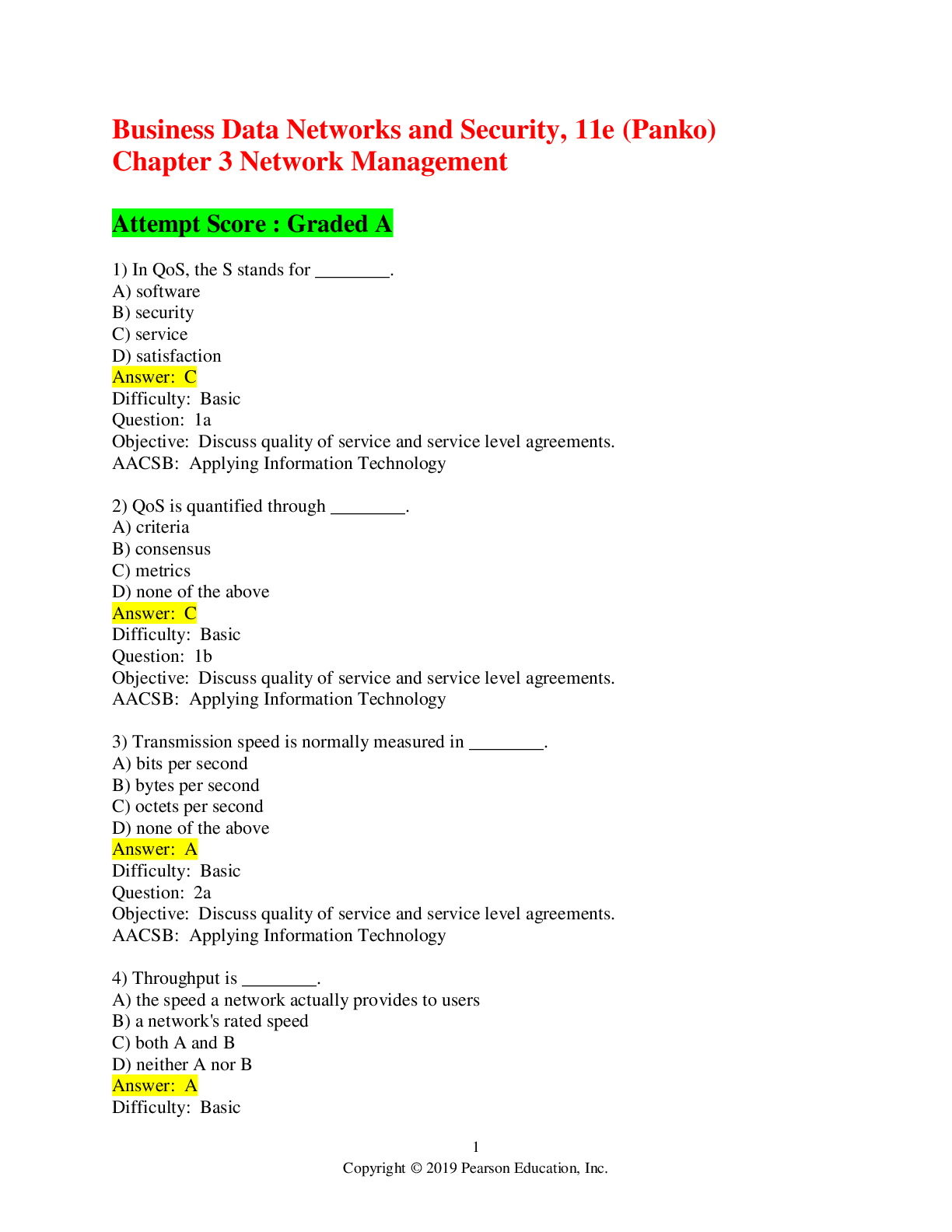
Reviews( 0 )
Recommended For You
Computer Networking> EXAM > Chapter 5 Ethernet (802.3) Switched LANs >Business Data Networks and Security, 11e (Panko) > 2023 > Score A+ (All)
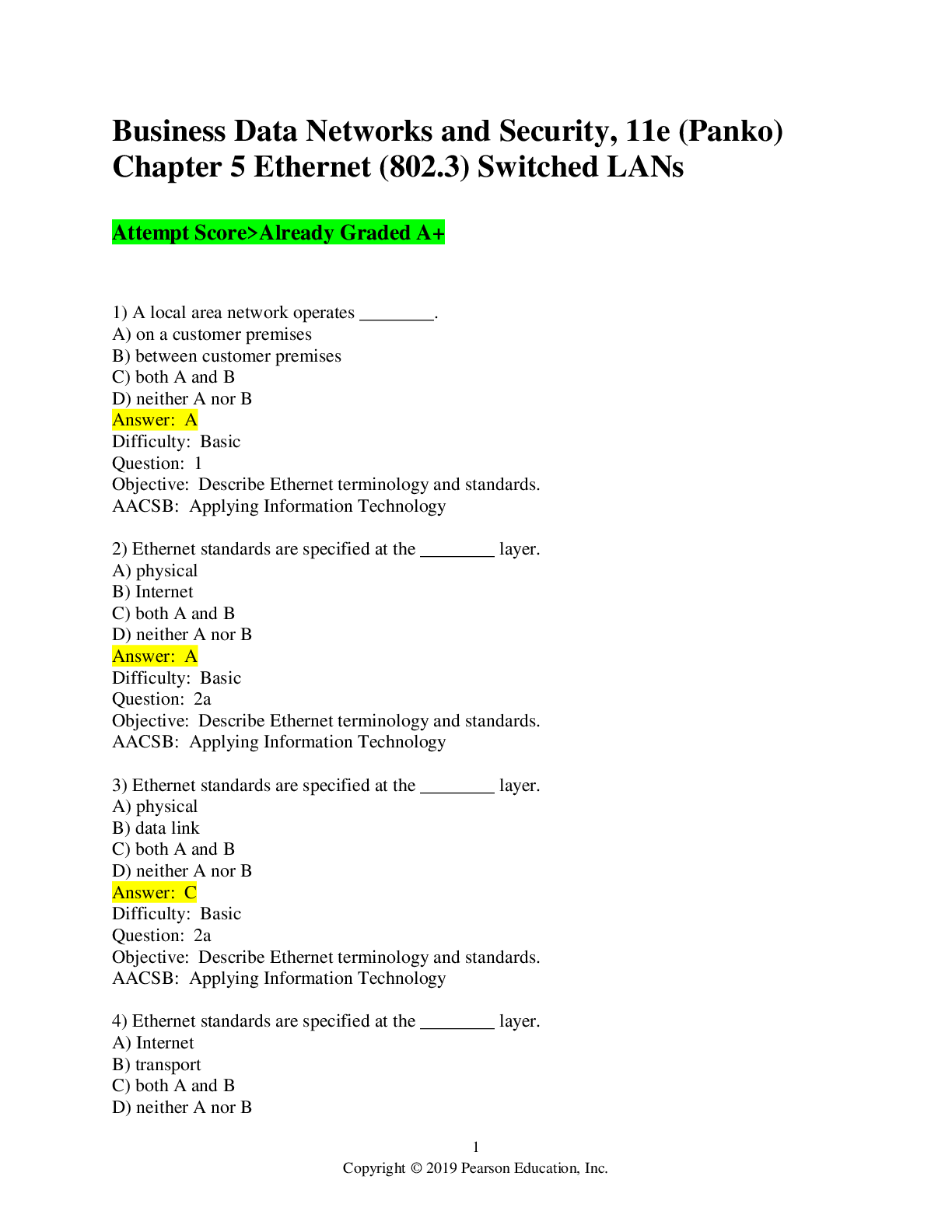
Chapter 5 Ethernet (802.3) Switched LANs >Business Data Networks and Security, 11e (Panko) > 2023 > Score A+
1) A local area network operates ________. A) on a customer premises B) between customer premises C) both A and B D) neither A nor B Difficulty: Basic Question: 1 Objective: Describe Ether net termino...
By Expert#1 , Uploaded: Sep 19, 2019
$7
Computer Networking> EXAM > Chapter 8 TCP/IP Internetworking I > Business Data Networks and Security, 11e (Panko) > Latest Exam > Score A+ (All)
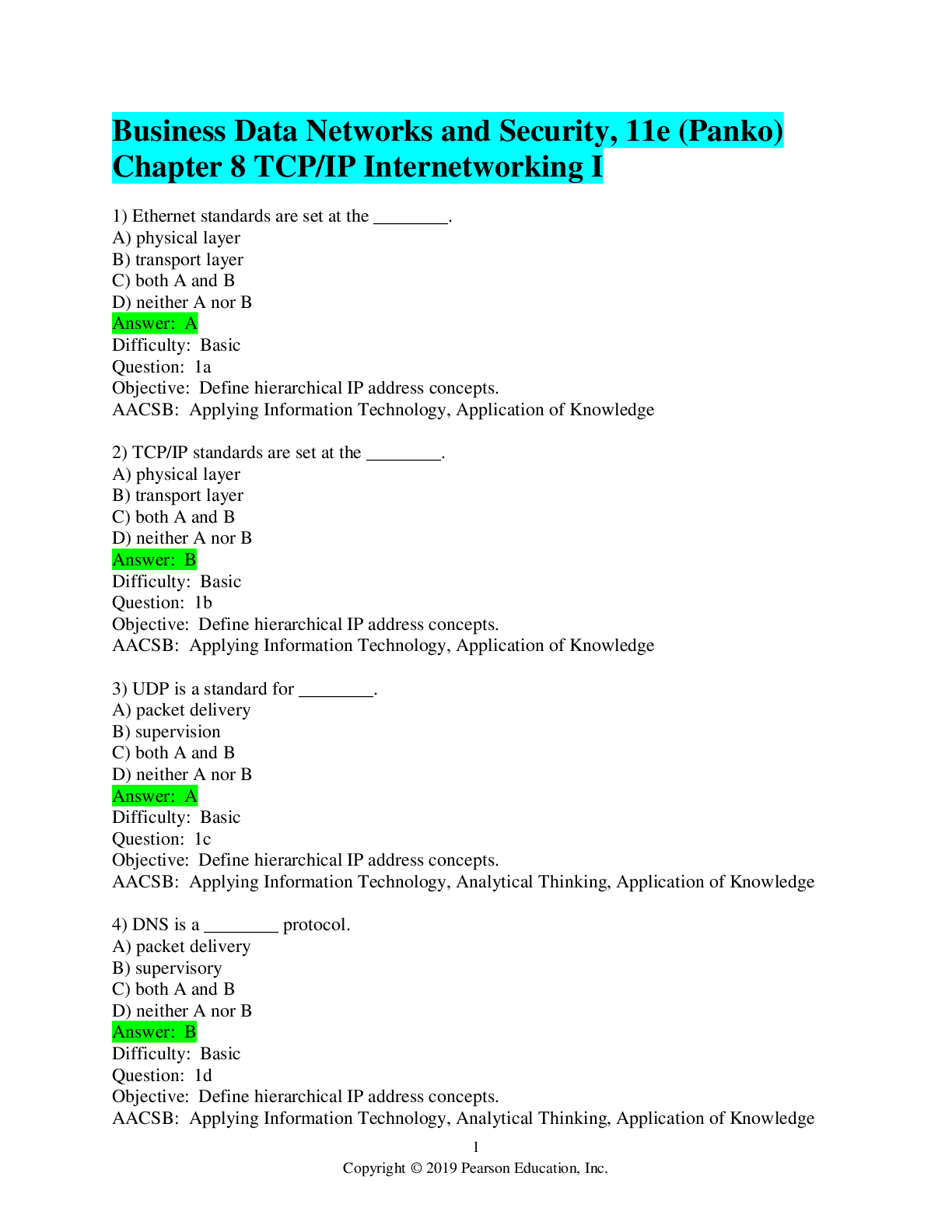
Chapter 8 TCP/IP Internetworking I > Business Data Networks and Security, 11e (Panko) > Latest Exam > Score A+
1) Ethernet standards are set at the ________. A) physical layer B) transport layer C) both A and B D) neither A nor B Difficulty: Basic Question: 1a Objective: Define hierarchical IP address concepts...
By Expert#1 , Uploaded: Sep 19, 2019
$8.5
Business Management> EXAM > Business Data Networks and Security, 11e (Panko) Appendix: Managing the Security Process>Attempt Score-All the Answers Correct {100% (All)
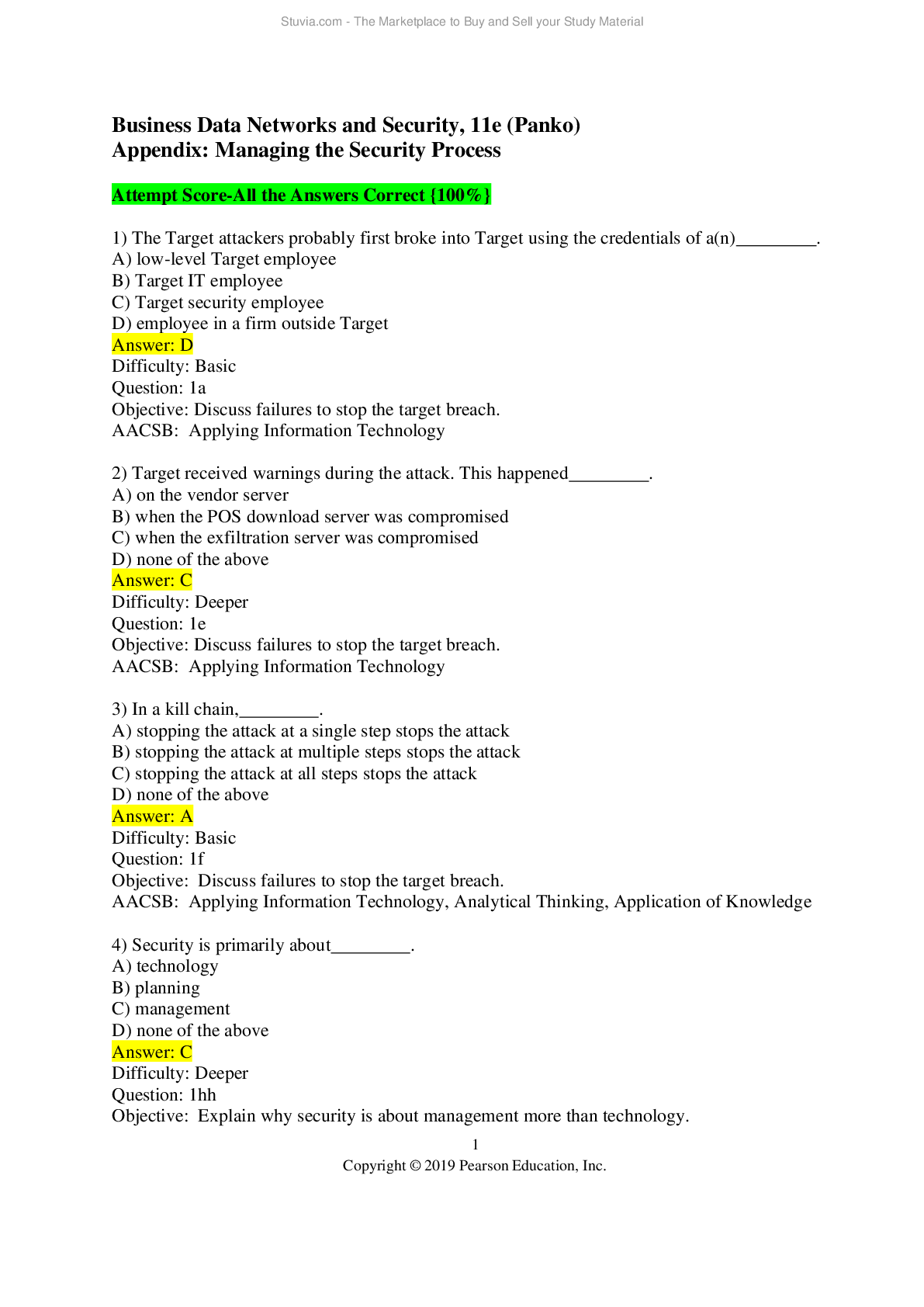
Business Data Networks and Security, 11e (Panko) Appendix: Managing the Security Process>Attempt Score-All the Answers Correct {100%
Business Data Networks and Security, 11e (Panko) Appendix: Managing the Security Process>Attempt Score-All the Answers Correct {100%
By QUIZ BIT , Uploaded: Jun 03, 2021
$10
Computer Networking> EXAM > Business Data Networks and Security, 11e (Panko) Chapter 4 Network Security (2019 Latest) Already Graded {A+} (All)
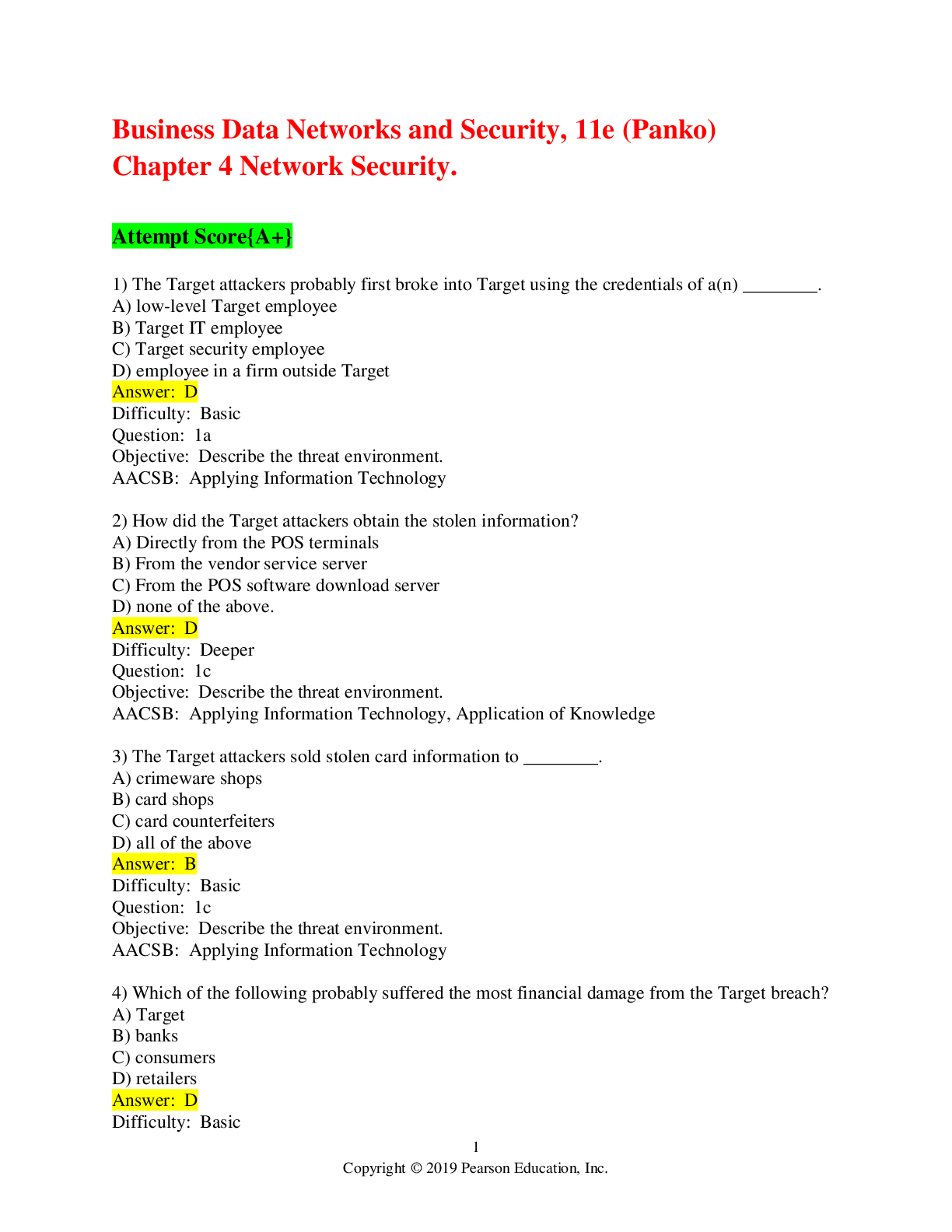
Business Data Networks and Security, 11e (Panko) Chapter 4 Network Security (2019 Latest) Already Graded {A+}
1) The Target attackers probably first broke into Target using the credentials of a(n) ________. A) low-level Target employee B) Target IT employee C) Target security employee D) employee in a fir...
By Expert#1 , Uploaded: Sep 19, 2019
$12
Computer Networking> EXAM > Chapter 6 Wireless LANS I > Business Data Networks and Security, 11e (Panko) > 2019 Latest Exam > Already Graded A (All)
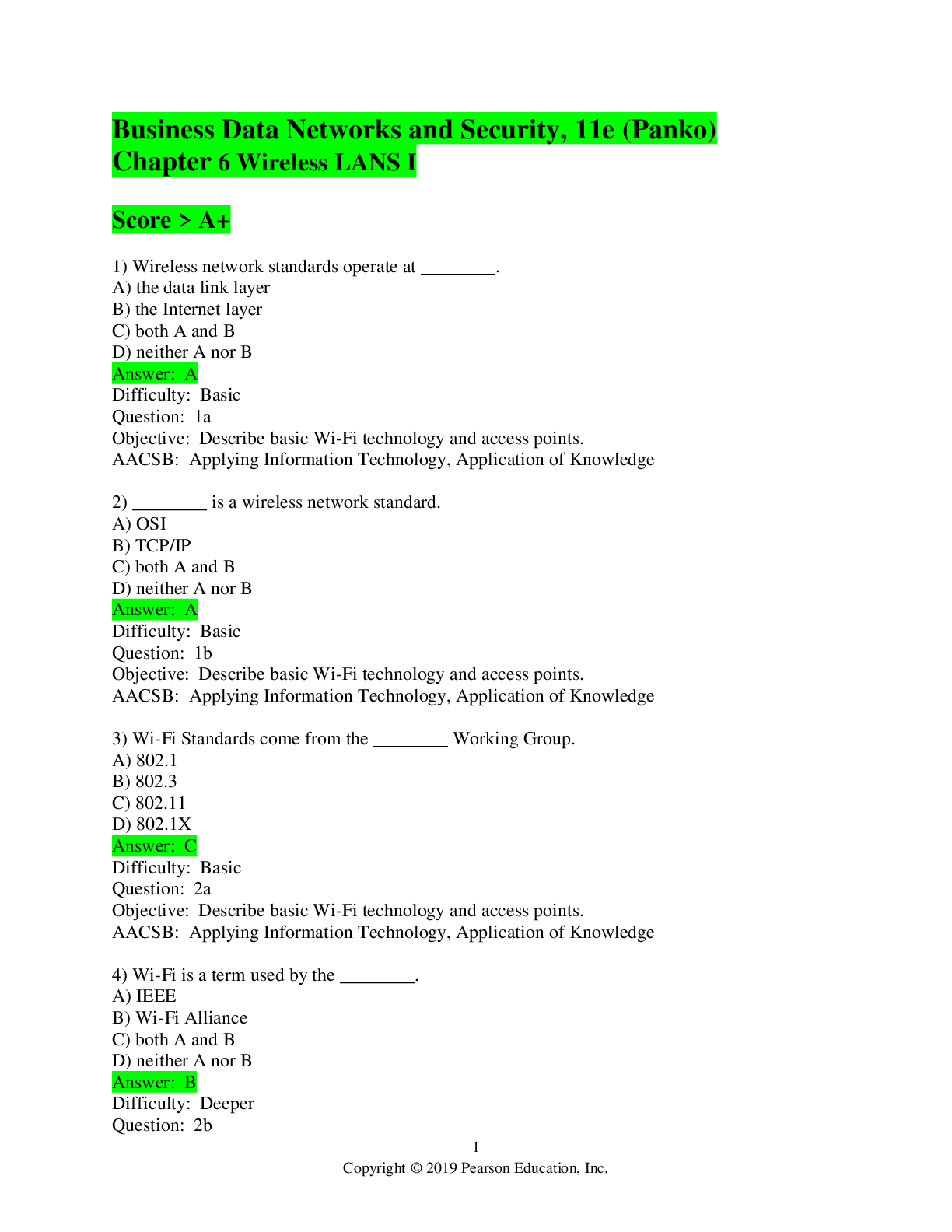
Chapter 6 Wireless LANS I > Business Data Networks and Security, 11e (Panko) > 2019 Latest Exam > Already Graded A
1) Wireless network standards operate at ________. A) the data link layer B) the Internet layer C) both A and B D) neither A nor B Difficulty: Basic Question: 1a Objective: Describe basic Wi...
By Expert#1 , Uploaded: Sep 19, 2019
$10
Computer Networking> EXAM > Chapter 7 Wireless LANS II > Business Data Networks and Security, 11e (Panko) > Clean {A} Latest Exam. (All)
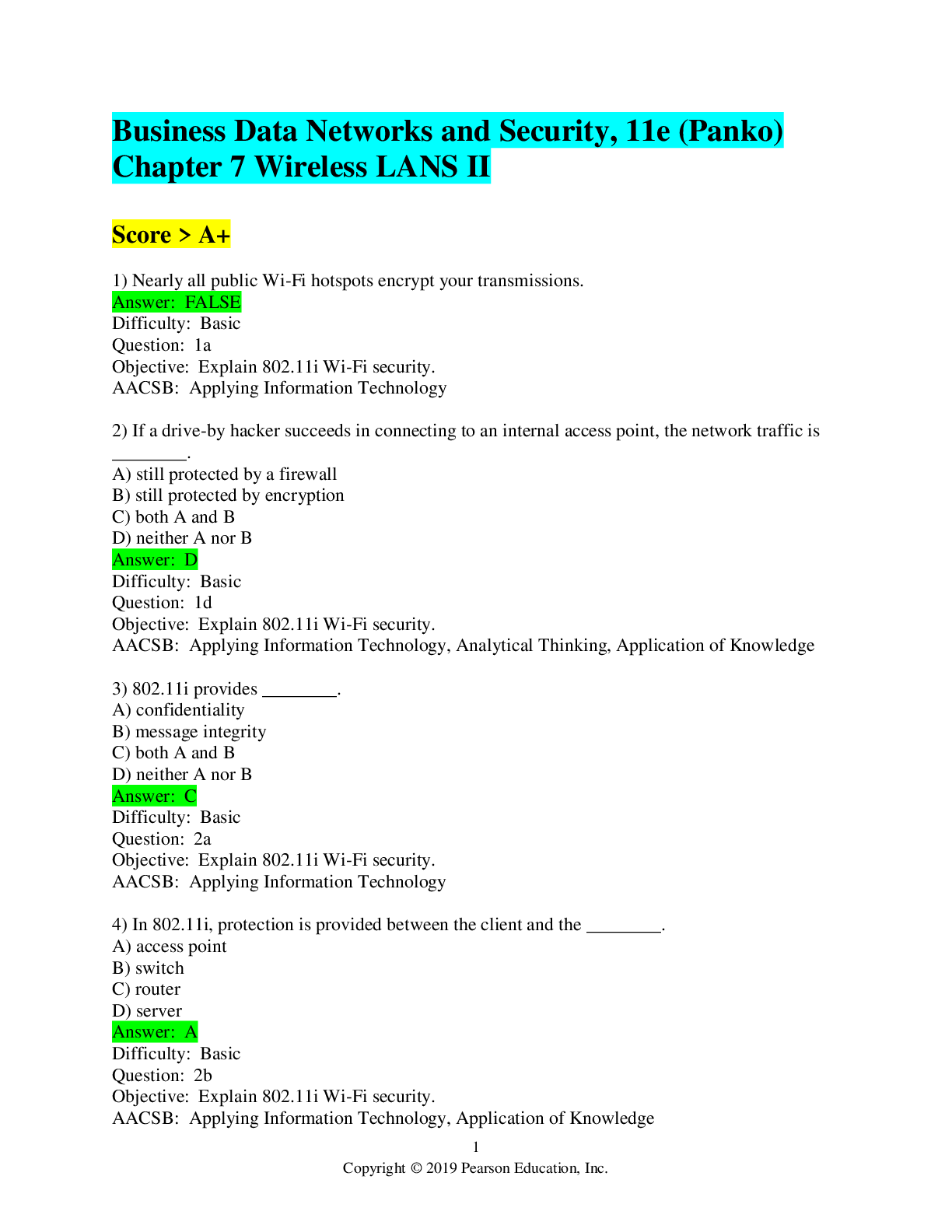
Chapter 7 Wireless LANS II > Business Data Networks and Security, 11e (Panko) > Clean {A} Latest Exam.
Business Data Networks and Security, 11e (Panko) Chapter 7 Wireless LANS II 1) Nearly all public Wi-Fi hotspots encrypt your transmissions. Answer: FALSE Difficulty: Basic Question: 1a Objective: Expl...
By Expert#1 , Uploaded: Sep 19, 2019
$13.5
Computer Networking> EXAM > Business Data Networks and Security, 11e (Panko) Chapter 2 Network Standards>Attempt score-100% correct (All)

Business Data Networks and Security, 11e (Panko) Chapter 2 Network Standards>Attempt score-100% correct
Business Data Networks and Security, 11e (Panko) Chapter 2 Network Standards 1) Internet standards are published as ________. A) RFCs B) IETFs C) TCP/IPs D) Internet Protocols Difficulty: Ba...
By Expert#1 , Uploaded: Sep 18, 2019
$10
Computer Networking> EXAM > Business Data Networks and Security, 11e (Panko)-Appendix: Managing the Security Process-Graded A+ (All)
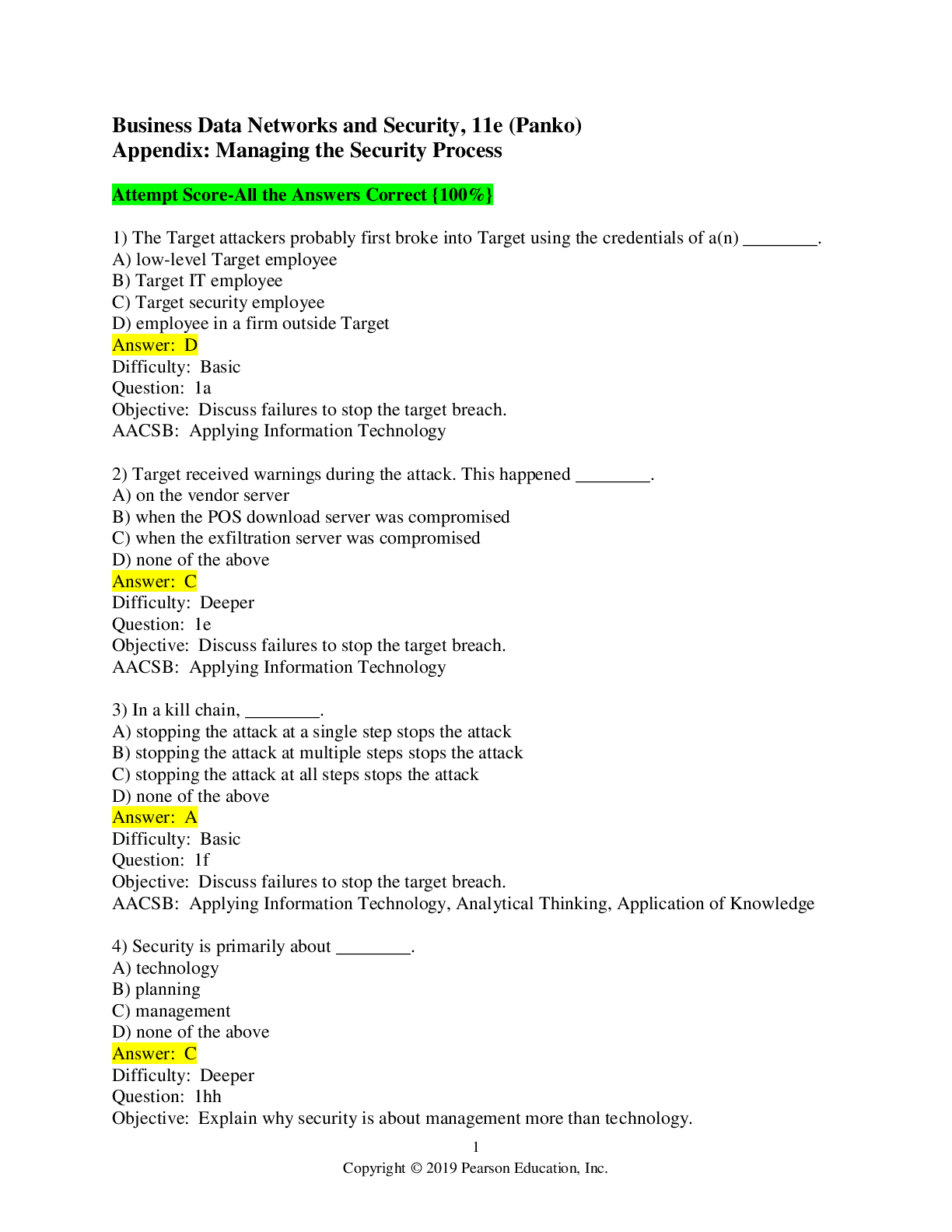
Business Data Networks and Security, 11e (Panko)-Appendix: Managing the Security Process-Graded A+
Business Data Networks and Security, 11e (Panko) Appendix: Managing the Security Process 1) The Target attackers probably first broke into Target using the credentials of a(n) ________. A) low-le...
By Expert#1 , Uploaded: Sep 19, 2019
$9.5
Computer Networking> EXAM > Business Data Networks and Security, 11e (Panko) > Chapter 1 Core Network Concepts and Terminology>2019>Scored A. (All)
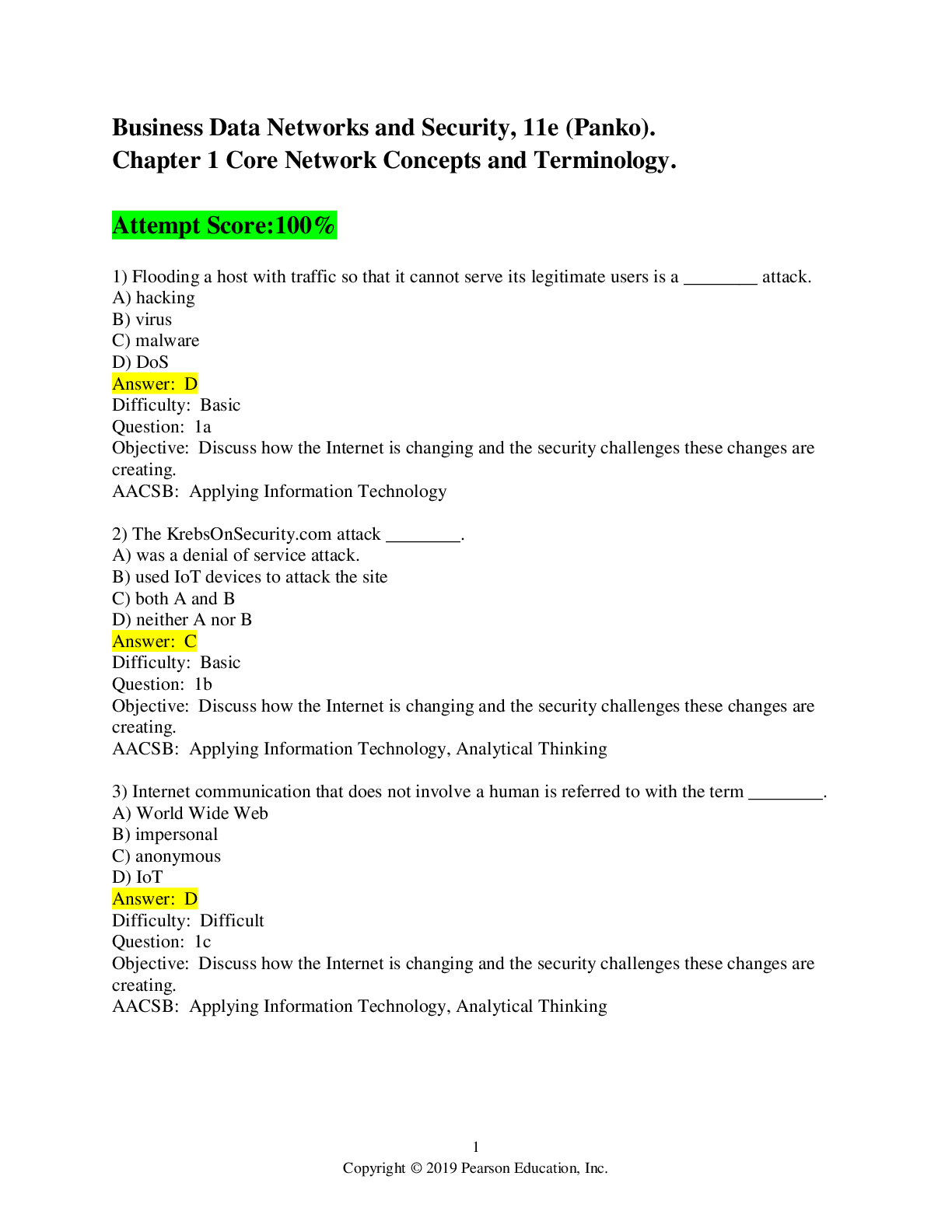
Business Data Networks and Security, 11e (Panko) > Chapter 1 Core Network Concepts and Terminology>2019>Scored A.
1) Flooding a host with traffic so that it cannot serve its legitimate users is a ________ attack. A) hacking B) virus C) malware D) DoS Difficulty: Basic Question: 1a Objective: Discuss how the Inter...
By Expert#1 , Uploaded: Sep 19, 2019
$9.5
Business> EXAM > Business Data Networks and Security, 11e (Panko) Chapter 5 Ethernet (802.3) Switched LANs-with verified answers-2022-2023 (All)
 Chapter 5 Ethernet (802.png)
Business Data Networks and Security, 11e (Panko) Chapter 5 Ethernet (802.3) Switched LANs-with verified answers-2022-2023
Business Data Networks and Security, 11e (Panko) Chapter 5 Ethernet (802.3) Switched LANs-with verified answers-2022-2023 1) A local area network operates . A) on a customer premises B) between c...
By Studyrepository , Uploaded: Nov 02, 2022
$8
Document information
Connected school, study & course
About the document
Uploaded On
Sep 19, 2019
Number of pages
17
Written in
Additional information
This document has been written for:
Uploaded
Sep 19, 2019
Downloads
0
Views
242






